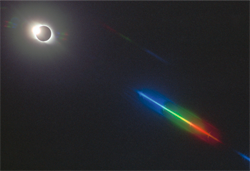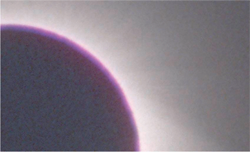




Workflow
 Robert Slobins: I use SilverFast Ai to drive a Nikon Coolscan LS5000 in the Windows environment. I just scan the negatives and manipulate them using SilverFast. Nothing really complicated. I chose this arrangement because of my need to extract as much information from a negative as possible. Wide dynamic range is important when imaging plasmas like the aurora or solar corona. It is also important when imaging such things as lunar eclipses or close planetary arrangements with a landscape.
Robert Slobins: I use SilverFast Ai to drive a Nikon Coolscan LS5000 in the Windows environment. I just scan the negatives and manipulate them using SilverFast. Nothing really complicated. I chose this arrangement because of my need to extract as much information from a negative as possible. Wide dynamic range is important when imaging plasmas like the aurora or solar corona. It is also important when imaging such things as lunar eclipses or close planetary arrangements with a landscape.
These images are illustrations, qualitative, not quantitative. There are no calibration images or other things that would allow one to get quantitative data in order to produce results for a research paper.
 I used to work in chemical darkrooms (B+W, then color). SilverFast allows me to produce similar results in a similar fashion. Actually, SilverFast, with its densitometer tool, allows me to correct color imbalances better; this includes crossover problems that one could never resolve conventionally. So, for example, the solar corona images you have seen have the solar corona as white as possible with as much detail in highlights and shadows as feasible. You can look at my scan of the 1998 total solar eclipse and note surface features of the moon as well as details close to the sun as an example of how SilverFast can get information out of a negative.
I used to work in chemical darkrooms (B+W, then color). SilverFast allows me to produce similar results in a similar fashion. Actually, SilverFast, with its densitometer tool, allows me to correct color imbalances better; this includes crossover problems that one could never resolve conventionally. So, for example, the solar corona images you have seen have the solar corona as white as possible with as much detail in highlights and shadows as feasible. You can look at my scan of the 1998 total solar eclipse and note surface features of the moon as well as details close to the sun as an example of how SilverFast can get information out of a negative.
 English
English Deutsch
Deutsch Français
Français Italiano
Italiano 日本語
日本語 Español
Español Português
Português Russian
Russian Chinese (Simp.)
Chinese (Simp.) Czech
Czech Polish (Store only)
Polish (Store only)